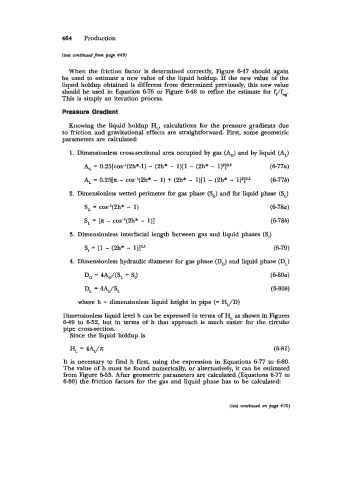Page 508 - Standard Handbook Petroleum Natural Gas Engineering VOLUME2
P. 508
464 Production
(fat continued from page 449)
When the friction factor is determined correctly, Figure 6-47 should again
be used to estimate a new value of the liquid holdup. If the new value of the
liquid holdup obtained is different from determined previously, this new value
should be used in Equation 6-76 or Figure 6-48 to refime the estimate for fJfv.
This is simply an iteration process.
Pressure Gradient
Knowing the liquid holdup H, calculations for the pressure gradients due
to friction and gravitational effects are straightforward. First, some geometric
parameters are calculated
1. Dimensionless cross-sectional area occupied by gas (4) and by liquid (4)
A, = 0.25[cos-’(2h*-l) - (2h* - 1)[1 - (2h* - l)*]0.5 (6-774
4. = 0.25[~ - cos-l(2h* - 1) + (2h* - 1)[1 - (2h* - l)2]0.5 (6-77b)
2. Dimensionless wetted perimeter for gas phase (S,) and for liquid phase (SA
S, = COS-'(^^* - 1) (6-78~)
S, = [n - COS-'(^^* - I)] (6-783)
3. Dimensionless interfacial length between gas and liquid phases (Si)
Si = [l - (2h* - l)]” (6-79)
4. Dimensionless hydraulic diameter for gas phase (D,) and liquid phase (D,)
D, = 4AJ(SL + Si) (6-80~)
D, = 4AJSL (6-80b)
where h = dimensionless liquid height in pipe (= HJD)
Dimensionless liquid level h can be expressed in terms of H, as shown in Figures
649 to 6-52, but in terms of h that approach is much easier for the circular
pipe cross-section.
Since the liquid holdup is
H, = 4AJn (6-81)
It is necessary to find h first, using the expression in Equations 6-77 to 6-80.
The value of h must be found numerically, or alternatively, it can be estimated
from Figure 6-53. After geometric parameters are calculated (Equations 6-77 to
6-80) the friction factors for the gas and liquid phase has to be calculated
(text continued on page 470)

